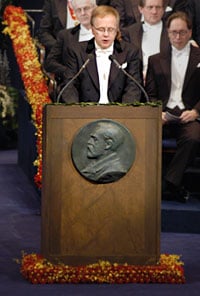Award ceremony speech
Presentation Speech by Professor Mats Jonson of the Royal Swedish Academy of Sciences, December 10, 2003.
Translation of the Swedish text.

Copyright © Nobel Media AB 2003
Photo: Hans Mehlin
Your Majesties, Your Royal Highnesses, Ladies and Gentlemen,
This year’s Nobel Prize in Physics is all about order! Not in the everyday world we see around us but in the microworld of electrons and atoms. This world, ruled by the laws of quantum physics, displays many spectacular phenomena not normally observable in the macroworld. In certain cases, however, a special type of order among electrons and atoms can amplify quantum phenomena of the microworld and make them visible, even to the naked eye. This year’s Nobel Prize in Physics goes to three scientists who have contributed to our understanding of the relation between order and those macroscopic quantum phenomena we call superconductivity and superfluidity.
As early as 1911, the Dutch physicist Heike Kamerlingh Onnes discovered that the electrical resistance of mercury disappears at a few degrees above absolute zero temperature. He called it superconductivity. The Russian physicist Pyotr Kapitsa later coined the analogous expression superfluidity to describe how liquid helium, at even lower temperatures, flows without internal friction or resistance.
From the very beginning it was felt that superconductivity may become of widespread importance in modern industrial society. By winding a superconducting wire into a coil, for example, it was thought possible to make powerful electromagnets that would not suffer energy losses. But unfortunately the first superconductors turned into ordinary metals even in weak magnetic fields. Later on, however, superconductors of a different type were discovered. By allowing superconductivity and magnetism to coexist they remained superconducting even in strong magnetic fields. The superconducting magnets which could therefore be made have become of great importance in modern society and are used, for example, in high resolution magnetic imaging devices for medical diagnostics and at large accelerator facilities used by particle physicists.
Two of this year’s Laureates, Vitaly Ginzburg and Alexei Abrikosov, have made decisive contributions to our understanding of how superconductivity and magnetism can coexist. Ginzburg formulated together with Lev Landau a theory that in more detail than before could describe how superconductivity disappears at certain “critical” values of electrical current and magnetic fields. They introduced a measure for the order among the electrons, which they called the superconducting order parameter. Guided by a deep physical intuition they went on to formulate mathematical equations whose solution determines the order in a superconductor. They found good agreement with what had been measured for superconductors known at the time. It is worth pointing out that the reasoning behind this Ginzburg-Landau theory was of such general validity that it is used today to gain new knowledge in many of the subfields of physics.
Soon, however, experiments were performed on new superconducting materials with results that were not expected. It was Abrikosov who discovered the more complicated type of order that explains these deviations. By an insightful analysis of the Ginzburg-Landau equations he was able to show how vortices may form in the spatial distribution of the order parameter and how a magnetic field through these can penetrate the superconductor. The vortices are essentially of the same type as those we can see form in the water when we empty a bath tub. Abrikosov was able to give a complete explanation of how superconductivity and magnetism coexist in a new class of what he called type II superconductors. This amounted to a breakthrough in the study of novel superconducting materials.
An order of an even more complicated kind can be found in the superfluid liquid of helium-3, which was discovered in the early 1970s. This was long after Kapitsa’s discovery of superfluidity in a liquid of naturally occurring helium, which is completely dominated by the heavier isotope helium-4.
There is an essential difference between the two isotopes. Helium-4 belongs to a class of particles called bosons that can be directly ordered into a superfluid by what we call Bose-Einstein condensation. Helium-3, on the other hand, is a fermion just like the electron. Such particles must first form pairs before they can reach the superfluid state.
It turns out that the atoms in liquid helium-3 form pairs with internal degrees of freedom. This is partly because the atoms rotate around each other, partly because of their magnetic properties – or spin, as the physicists say. As a consequence the Ginzburg-Landau order parameter has here not only two – as in the superconductors – but eighteen components and the superfluid is anisotropic; it can have different properties in different directions.
It was Anthony Leggett who succeeded in explaining the relationship between the properties of the new superfluid and the many different types of order that this complicated order parameter allows. His theory helped the experimentalists to interpret their measurements and provided a framework for systematic investigations. Leggett’s theory has also been used in other fields, as diverse as liquid crystal physics and cosmology.
Professor Abrikosov, Professor Ginzburg, Professor Leggett.
You have been awarded the 2003 Nobel Prize in Physics for your pioneering contributions to the theory of superconductors and superfluids. It is an honour for me to convey to you the warmest congratulations of the Royal Swedish Academy of Sciences. I now ask you to step forward to receive your Nobel Prizes from the hands of His Majesty the King.
Nobel Prizes and laureates
Six prizes were awarded for achievements that have conferred the greatest benefit to humankind. The 12 laureates' work and discoveries range from proteins' structures and machine learning to fighting for a world free of nuclear weapons.
See them all presented here.
